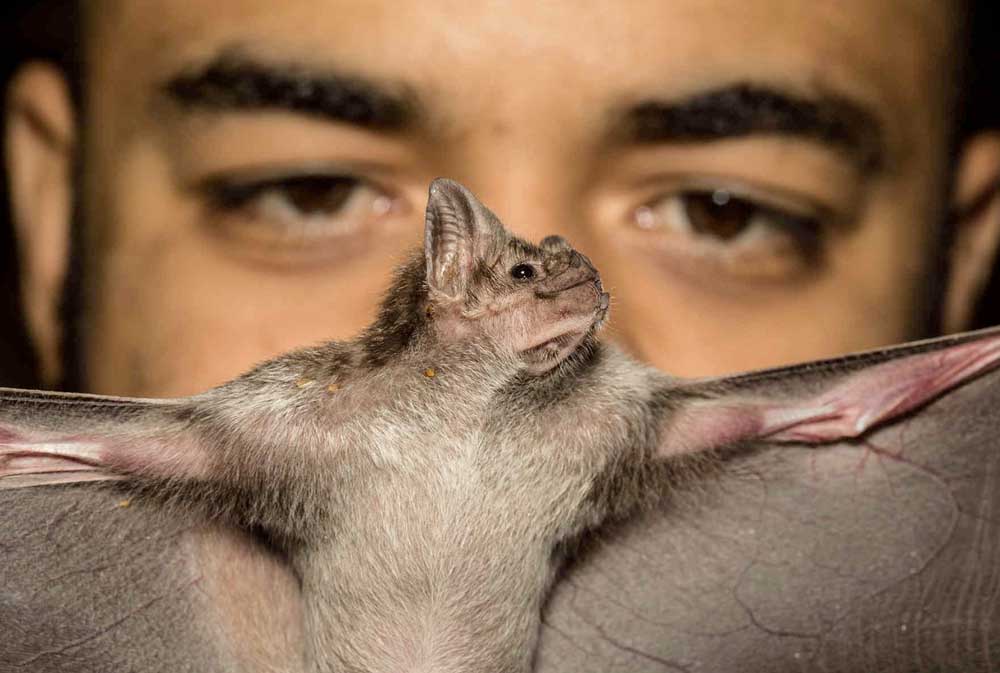Desmodus rotundus, vampire bats, transmit dangerous infections, and brucellosis is a hazardous zoonotic disease, two adversities that coexist in the subtropical and tropical areas of the American continent. Here, we report a 47.89% Brucella infection prevalence in a colony of vampire bats inhabiting the tropical rainforest of Costa Rica. The bacterium induced placentitis and fetal death in bats. Wide-range phenotypic and genotypic characterization placed the Brucella organisms as a new pathogenic species named Brucella nosferati sp. nov., isolated from bat tissues, including the salivary glands, suggesting feeding behavior might favor transmission to their prey. Overall analyses placed B. nosferati as the etiological agent of a reported canine brucellosis case, demonstrating its potential for infecting other hosts. To assess the putative prey hosts, we analyzed the intestinal contents of 14 infected and 23 non-infected bats by proteomics. A total of 54,508 peptides sorted into 7,203 unique peptides corresponding to 1,521 proteins were identified. Twenty-three wildlife and domestic taxa, including humans, were foraged by B. nosferati-infected D. rotundus, suggesting contact of this bacterium with a broad range of hosts.
The discovery that a high proportion of vampire bats in a tropical area is infected with pathogenic Brucella nosferati and that bats forage on humans and many wild and domestic animals is relevant from the perspective of emerging disease prevention. Indeed, bats harboring B. nosferati in their salivary glands may transmit this pathogenic bacterium to other hosts. This potential is not trivial since, besides the demonstrated pathogenicity, this bacterium possesses all the required virulent arsenal of dangerous Brucella organisms, including those that are zoonotic for humans. Our work has settled the basis for future surveillance actions in brucellosis control programs where these infected bats thrive. Moreover, our strategy to identify the foraging range of bats may be adapted for exploring the feeding habits of diverse animals, including arthropod vectors of infectious diseases, and therefore of interest to a broader audience besides experts on Brucella and bats.
Considering that the B. nosferati was isolated from the bats’ gut contents of 47% of infected animals, we cannot dismiss the possibility that bats could have taken this bacterium from a third-party reservoir. We neither have attempted isolation in other potential hosts nor conducted a survey on antibodies against Brucella in wildlife. However, others have reported the presence of anti-Brucella antibodies in the blood of tropical wildlife mammals such as peccary, agouti, capybara, coati, raccoon, foxes, wild felids, otters, monkeys and tyras, all animal species identified in this work as prey of infected vampire bats. Moreover, the B. nosferati BCCN84.3-infected dog lived in an area inhabited by D. rotundus bats.
Of note is the recent description of an emerging B. amazoniensis infecting humans working in the deep Amazonian rainforest, which probably acquired the bacteria through contact with tropical wildlife, including bats. Although this bacterium is a different species, it branched closer to B. nosferati than other species. Likewise, a high seroprevalence in wild peccaries and capybaras was found in a tropical region of Venezuela with the concomitant isolation of organisms typed as B. suis using classical bacteriology. However, conventional bacteriological typing cannot distinguish B. suis from B. nosferati. The closeness to areas with vampire bat attacks and the absence of pigs (B. suis reservoirs) in the vicinities where these sylvatic bacterial species were isolated suggest the presence of zoonotic Brucella organisms in these tropical South American areas.
Our approach identified the feeding preferences of a Brucella-infected D. rotundus colony. Many studies through various decades have documented that D. rotundus feeds on several domestic and wildlife animals. In a single study, we identified the prey preference spectrum of a colony of Brucella-infected vampire bats in a given complex area, demonstrating the potential of our approach for control strategies in Latin America, where vampire bats thrive. This practice is particularly relevant when sudden outbreaks of infectious diseases such as rabies or brucellosis emerge in a given area, and the potential range of reservoirs requires fast identification for sanitary actions and epidemiological surveillance. Moreover, the same approach may be used to identify arthropod vector prey preferences.
Vampire bats forage on humans in the surroundings of the Piedras Blancas National Park. Close to 35 bat bites in humans were reported in 2021 by the Costa Rican Ministry of Health. However, the number of bites is expected to be higher since these events are often unreported. Several investigators have also described a high incidence of vampire bats foraging on humans (up to 88% of the inhabitants) in tropical ecological conditions similar to those presented here. Humans are abundant potential diurnal prey that have not developed natural defense mechanisms against vampire bat attacks when these chiropters hunt for blood at night. Bats frequently enter rural houses and shelters in tropical areas of Costa Rica.
Considering the high prevalence of Brucella infections in D. rotundus, further studies are needed in prey victims to assess the zoonotic potential of B. nosferati. Unfortunately, in Latin America, including Costa Rica, bacterial isolation is seldom attempted in animals and humans, precluding the opportunity to identify the Brucella species.
It has been noticed that vampire bats reproduce better and in larger groups, precisely in those border areas where foraging is abundant, adjusting their immune response and favoring certain diseases over others. Following this, it is not surprising that D. rotundus is becoming a plague in certain areas where livestock and humans are abundant. Our recent experience suggests that bats may be reservoirs of novel and dangerous infectious diseases for humans and animals. Therefore, identifying a new species of pathogenic bacteria in D. rotundus vampire bats and establishing the range of potential hosts in a given environment are relevant for epidemiological studies and for preventing zoonotic infectious diseases, including brucellosis.
Address correspondence to Edgardo Moreno, emoreno@una.cr.
Carlos Chacón-Díaz, Andres Moreira-Soto, Jan Felix Drexler and Edgardo Moreno contributed equally to this article.

